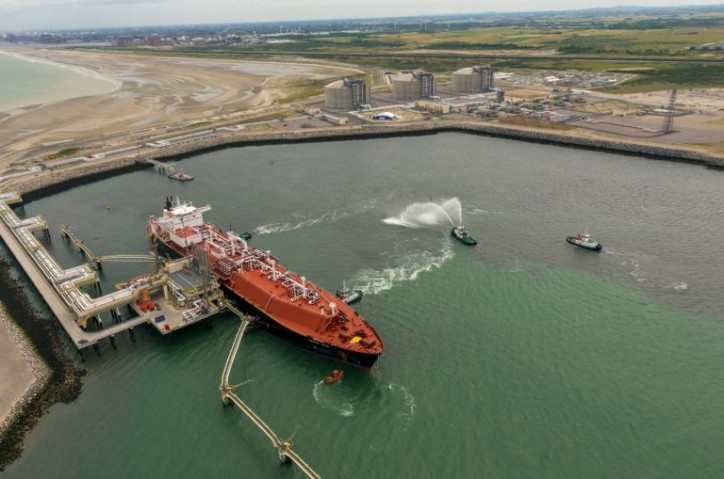On 1 January 2017, commercial operations started up at the Dunkirk regasification terminal. This commissioning draws a line under one of the largest industrial construction sites in France.
The Dunkirk terminal is used to import, store and regasify liquefied natural gas (LNG) before delivery with the transmission systems to the places of consumption.
Ideally sited to serve a range of markets
The Dunkirk regasification terminal is the second largest in mainland Europe and is the only one in Europe to be directly connected to two consumption markets: France and Belgium. Its annual regasification capacity of 13 billion m3 accounts for more than 20% of French and Belgian natural gas consumption.
Due to its industrial design, the regasification terminal provides its customers with safe, flexible and extremely reliable services. Its siting in Dunkirk is the ideal position at the crossroads of the seaways between the Channel and the North Sea close to natural gas consumption markets in France and North-Western Europe.

Madrid Spirit at the Dunkirk LNG terminal (Image: Dunkerque LNG)
Cutting edge facilities
The regasification terminal is located within the enclosure of the Dunkirk harbour on a site of 56 hectares and is composed of:
- a jetty that can receive up to 150 LNG tankers per year: from the largest LNG tankers in the world (Qmax tankers with capacity of 267,000 m3) to low-capacity tankers (65,000 m3) for the regional markets. Five articulated arms are installed to unload the ships at maximum flow rate of 14,000 m3/h;
- three isothermal LNG storage tanks, that can each contain 200,000 m3;
- a regasification unit made up of 10 heat exchangers, supplied with tepid water by the neighbouring nuclear power plant in Gravelines with an underwater tunnel 5 km long. This industrial innovation thus provides energy savings that are equivalent to the annual gas consumption of the Dunkirk community.
Natural gas, essential for energy transition
Due to reduced greenhouse gas emissions and absence of fine particles, natural gas has lower environmental impact than other types of fossil fuel, such as oil and coal.
It contributes to energy transition providing a useful complement to carbon-free nuclear power and renewable energies, especially during peak consumption. This increasing complementarity is also revealed in domestic applications, whose technology is being completely overhauled.
Natural gas also has a promising future as transport fuel. In liquefied form at -162°C, its volume is reduced by 600 times, thus facilitating transport and storage. LNG is the choice alternative for long-haulage trucks and maritime navigation, where stricter standards are applied in certain seas, such as the Channel, North Sea and Baltic Sea.
Marc Benayoun, Executive Director of the EDF Group, in charge of the Gas Sector and Italy, stated: I am delighted that commercial operations have started up at the Dunkirk regasification terminal, thus creating a new point of gas importation in France and strengthening security of supply in Europe. It also contributes to the development of the gas supply market, on which the Group already operates with its Italian subsidiary, Edison, and wishes to further strengthen its share. I would especially like to thank the EDF, partners and contractors teams who have worked together since 2012 to complete this strategic asset.
Pascal De Buck, CEO of Fluxys, said: I would like to congratulate and thank all the teams who have contributed to the success of this extensive infrastructure project. At Fluxys, we are especially proud to have been able to contribute by bringing our 30 years of expertise in the field of LNG to the construction of this terminal. In addition, direct connection of the Dunkirk LNG terminal to our Belgian network provides users with easy and flexible access to the natural gas consumption markets in North-Western Europe.
Source: EDF